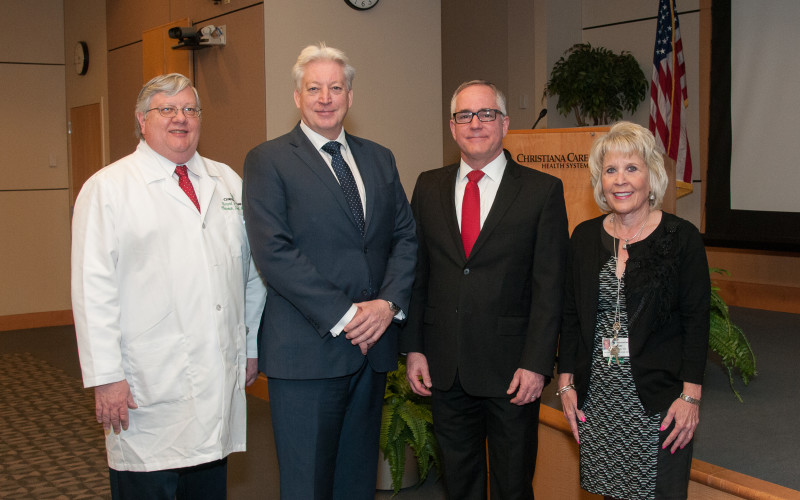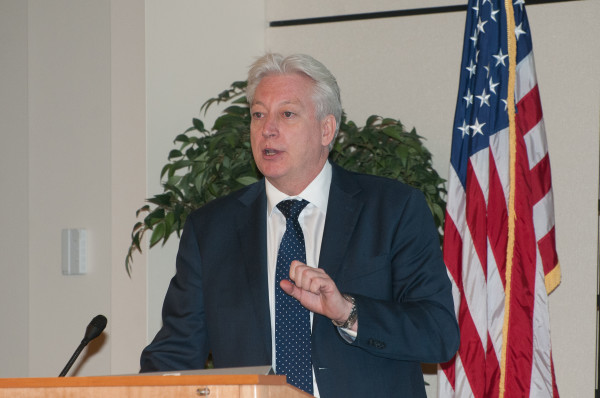British professor shares insights on achieving health care’s Triple Aim

Professor Michael “Monty” Mythen, M.D., a thought leader in the United Kingdom’s quest for its own version of the health care Triple Aim, shared his experience as an intensivist, anesthesiologist and researcher at combined Surgical and Anesthesia Grand Rounds at the John H. Ammon Medical Education Center at Christiana Hospital. Dr. Mythen is the Smiths Medical Professor of Anaesthesia and Critical Care and honorary consultant, anaesthesia and critical care, University College London.
In his introductory remarks, Mark Schneider, M.D., MBA, interim chair of the Department of Anesthesiology at Christiana Care, said Dr. Mythen’s experience provides “an exemplary base” for Christiana Care’s journey to reach the Triple Aim of improving the quality of the health care experience, improving the health of the population and reducing per capita cost.

Dr. Mythen’s lecture, “Enhanced Surgical Recovery: Reducing Variation — U.K. Experience — U.S. Opportunity,” highlighted his experience as team leader of the U.K.’s National Health Service (NHS) sponsored Enhanced Recovery Partnership. Enhanced surgical recovery (known also as rapid recovery), “is a modern, evidence-based model of care that creates healthier patients who recover faster from major surgery,” according the NHS official website.
At a time when the British government was changing leadership in 2010, the British National Health System received a mandate to increase the quality of care in the face of a budget freeze on health care expenditures and an expected 20 percent cost increase over the next few years.
Dr. Mythen said reducing variation became essential for improving quality of care while controlling costs, even though the national health system in the U.K. already had an excellent reputation for cost-efficiency.
One “wild variation” that Dr. Mythen and colleagues found ripe for investigation was the length of hospital stay across the country for colorectal resection patients, which ranged from five to 18 days. He pointed out similar variation in the United States; one study of 499 institutions in California showed variations in length of stay, complications and mortality comparable to the U.K. study.
According to Dr. Mythen, iatrogenic harm — harm introduced by the surgeon, physician or health care provider — was central to the problem where length of stay was longest and consequently the cause of financial loss for many of the hospitals under review. However, the iatrogenic harm was not the result of health care providers doing anything “wrong” per se. Rather, it was the care “traditions” that were harmful, causing high rates of morbidity and mortality, thus reducing health care quality and driving up costs.
Dr. Mythen referenced Henrik Kehlet, M.D., a colorectal surgeon from Denmark, as “the grandfather of enhanced recovery” and someone who has long argued that the traditional environment and practices for patients after colorectal surgery Is not evidence-based.
“Dr. Kehlet had been saying for decades that ‘we can get them out in 24, 48, 72 hours after open or laparoscopic [colorectal] surgery by just [ignoring] all of the iatrogenic nonsense that we’ve been telling each other is somehow evidence-based. But we can’t find the evidence.’”
Patients are fitter sooner and ready to go home earlier with reduced complications, he said. The model of care is safe and effective, ensuring patients are partners in their care — focusing on less-invasive surgical techniques, pain relief and the management of fluids and diet, which help patients to recover better post-operatively with no additional burden on primary or social care.
Prefacing his lecture, Dr. Mythen sketched his 2012 experience as laboratory leader for Caudwell Xtreme Everest 2 Project at the Smith’s Medical High Altitude Laboratory in Nemche, Nepal. Other researchers in the project included surgeons, anesthesiologists and critical care doctors interested in the human factors and implementation science essential to getting the Triple Aim to be accurate.
Comparing teamwork high in the Himalayan Mountains with the environment in London, he said, “The joke was that it is easier to get four doctors together on the summit of Mt. Everest to agree than it is to get them to change their daily practice.”
Why?
“If they make a mistake up there … they’re probably all four going to die, whereas, if they’re having a bad day at the office it’s usually someone else who gets hurt, and that’s the patient,” he said. Continuing his mountain-climbing metaphor, he urged his colleagues to “stay focused on the fact that that patient’s on the rope with us and we’re all part of a team together.” When guided by this sense of partnership, systems changes become much easier.